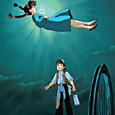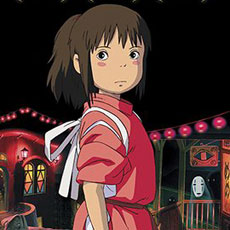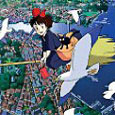Studio Ghibli (July 16, 1994), Walt Disney Home Entertainment (August 16, 2005), 2 discs, 119 mins plus supplements, 1.78:1 anamorphic widescreen, Dolby Digital 2.0, Rated PG, Retail: $29.99
Storyboard:
A group of mystical forest creatures try to save their home from developers. Oh, but there’s so much more to it than that!
The Sweatbox Review:
Now that was different.
But that’s the great thing about watching films from overseas. When you plop an animated movie like Japan’s Pom Poko into your DVD player, you just know that you are not going to see the same old “young person leaves home to find himself/herself, and returns a hero, with humorous sidekick in tow” type of movie we have become so accustomed to in North America. The 1994 film Pom Poko was part of a 2005 wave of Studio Ghibli releases to come to stores from Walt Disney Home Entertainment, and it’s a wonderfully unusual film that defies your expectations to provide a unique viewing experience.

Unlike most of Disney’s previous Ghibli releases, the films in this wave were not directed by Hayao Miyazaki. Instead, Miyazaki is credited with only the film’s concept, and the directorial chores are taken care of by his colleague, Isao Takahata. Until now, Takahata’s most well known work to American audiences has been the critically acclaimed Grave of the Fireflies. Given the grim nature of that film, and the playful imagery of Pom Poko’s box art, I was really not sure what to expect. I was nearly certain that the film would be remarkable, but would it be played seriously or humorously? After watching it, the answer is still not so simple.
I’m anxious to say more, but before I go on I should discuss the plot: With urban development ever-more encroaching upon the forests in crowded Japan, a group of raccoons (well, actually they are tanuki, but the English dub calls them raccoons) must protect their own forest from being developed (and destroyed) by humans. The raccoons live in Tama Hills, which is both their ancestral home as well as the target of the latest suburb project. Legends say that the raccoons of Tama Hills have the ability to change their form, but over the years the raccoons have become lazy and complacent, and have taken to fighting among themselves over dwindling land and food supplies; seemingly, they have lost their ability to transform. With the dangerous advancement of humankind into their territory, the raccoons must work together to re-discover their age-old abilities in order to protect their home.
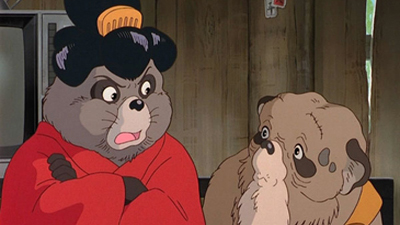
It is an older raccoon named Oroku who unites the raccoons and sets them on the path to cooperation. They enter into a five-year plan, beginning with observation of the humans and the learning of the ancient art of transformation. Unfortunately, the raccoons are lazy and easily distracted, but eventually they do take their war to the humans. This is a war with consequences, as people actually die in the raccoon-generated “accidents”. One raccoon in particular named Gonta (voiced by Clancy “Lex Luthor” Brown in the English dub), becomes quite bloodthirsty, while other raccoons lament the potential loss of burgers and popcorn if all the humans are killed. This dichotomy between the serious and the funny exists throughout the film.
Although some of the raccoons do show some talent for transformation, it soon becomes apparent that the efforts of the raccoons is not enough, and they send two of their own to other raccoon towns in order to find transformation masters. One raccoon is successful, and Tama Hills becomes the new residence for a set of eccentric old raccoons with remarkable transformation powers. They are successful in making an army of shape-shifting wizards, but the fight to stop the development seems doomed.
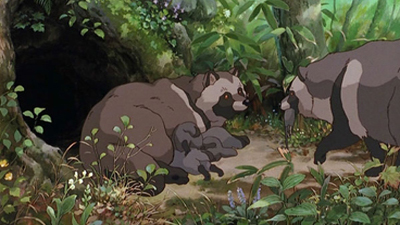
Meanwhile, a transforming fox becomes involved in the conflict, trying to bring together the raccoons and a theme park developer. This alters the course of the conflict, yet the outcome still seems foretold. As the ending becomes more obvious to all, various factions among the raccoons take their own paths— some tragic, some poignant. And then there’s the scene of scrotal warfare that ranks among the oddest scenes in animated film history. (If you don’t know what I mean by “scrotal”, consult a medical dictionary. I’m not going to describe it. You have to see it to believe it. And, they are not “pouches”, as the English dub clumsily describes them.)
The animation varies from ultra-realistic to very cartoony, reminiscent of the simplest anime, but it is all of high quality (given the lower frame rate in Japanese features). In some scenes, the raccoons look almost photorealistic, and in others they are barely recognizable as raccoons. Most of the movie, they exist in a cuddly in-between state, as seen on the cover graphic. The animation also ventures into the symbolic, such as the representation of urban development early in the film. The biggest tour de force is a scene where the empowered transforming raccoons put on an amazing display in the human settlement in an effort to impress and frighten the people.
Another thing that sets this film apart is the ongoing narration, given in a warm, straightforward way by Maurice LaMarche in the English dub. It has the odd effect of reminding one of Disney’s True Life Adventures films, minus some of the folksiness. The narrator provides a timeframe, e.g. “Year 33 of the Pom Poko era” (whatever that means), and puts the events in context with Japanese legends and the history of urban development in Japan.
Playing at just under two hours, this story has plenty of time to unfold; however, one could criticize it for not knowing where exactly it was unfolding towards. This is a film more about an idea than a theme, as the message it is trying to convey is not clear. The raccoons do seem to represent the more sympathetic side in the conflict, and yet the humans are not necessarily portrayed as being particularly bad. The narrative thrust of the film is also weak; what we see is more a series of events than a story, but at the same time I was still entranced. And yet I wonder— maybe we are so used to formulaic moviemaking that it just seems odd to experience an honest-to-goodness story— one that does not conform to our expectations, and yearns only to amaze and delight us with its ideas… as well as to make us think. What a concept.

The inconsistent tone may also put off some viewers, dabbling as it does with both tragedy and playful humor. Of course, this does represent what real life is like. People do, after all, still manage to crack jokes at funerals— even if disapproving glances are given. I can only assume that Takahata was going for a natural form of storytelling that combines contradictory emotions just like real life. Again, this may be off-putting to some viewers, but it worked for me.
So, what did I think? I liked it. You may not, but I did. I appreciated the unusual story, the interesting ideas, and the beautiful animation techniques. The plot may seem plodding or repetitive to some, yet I liked that I didn’t know where the story was going, even though I generally knew what the outcome would be. That may not make sense, but it’s just that kind of film. Even without the scrotal warfare, this is unique tale that presents a problem with no easy solutions and no tidy ending— just like life.
And if you think I’m crazy for liking such a weird little movie, I’ll just mention that it was the 1995 Annecy International Animated Film Festival Grand Prix winner for Best Animated Film. So I guess I’m not the only crazy one out there.
Is This Thing Loaded?
Unfortunately, this unique entry in the Ghibli oeuvre is given little in the way of extras. Disc 1 has just under 8 minutes of Trailers And TV Spots, where Pom Poko is described as showing “comical raccoons in a nostalgic tale”.

Disc 2 has the Complete Storyboards for the film. This is always a neat thing to watch, but don’t you wish Disney would do this for some of their own movies too? And, while I am always impressed that Disney would include a full disc of just storyboards, additional material about the film would have been great.

Case Study:
Keepcase with tray, in a slipsleeve that duplicates the cover.
Ink And Paint:
The 16:9 anamorphic image, just like Disney’s other Ghibli releases, is simply perfect. The colors in this film are a little more vibrant than some of the other Ghibli films, and they are reproduced beautifully. There is simply no instance of compression artifacts, shimmering, or haloing to be seen. Dropping THX certification does not seem to have hurt at all. Likewise, the print used is pristine. The film couldn’t look better.

Scratch Tracks:
You may choose from either English or Japanese 2.0 tracks. As usual, the Disney-produced English dub is far less annoying than most other dubs, featuring as it does such talents as Maurice LaMarche, Clancy Brown, and Tress MacNeille. Both language tracks are relatively vibrant 2.0 mixes, perfectly adequate but falling short of what a 5.1 mix could have achieved.
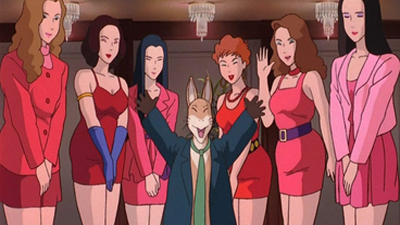
There are three subtitle tracks, all in English. There is a subtitle track for the English spoken dialog, a closed captioning track that is notable for having a different version of the Japanese translation, and a third track that only provides translations for written Japanese on-screen (this defaults along with the English language audio).
Final Cut:
Okay, if you want all your animated films to have happy endings and singing princesses, you might want to avoid this one; but if your tastes are more eclectic, and you crave something a little different, you may find this film rewarding. The craftsmanship is undeniable, and the story is certainly unique. The story structure and tone take getting used to, but the film does have its rewards. Disney has done its usual fine job of presenting the film in a nice 2-disc set, even if more extras would have been nice. I would love to know what Takahata would have to say about this unusual film of his.
 | ||
 |






